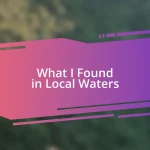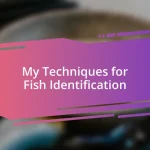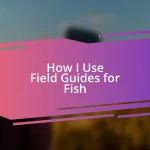Key takeaways:
- Fish identification combines science, observation, and intuition, with understanding fish behavior and habitat being crucial for accurate identification.
- Essential tools like field guidebooks, smartphone apps, and underwater cameras enhance the fish identification process and deepen appreciation for local ecosystems.
- Documenting findings in a fish journal and engaging with the fishing community fosters personal growth and contributes to citizen science efforts in preserving aquatic environments.

Understanding Fish Identification Basics
Fish identification is a fascinating art that combines science, observation, and a bit of intuition. I still remember my first time on a fishing trip with my grandfather; he could effortlessly distinguish between species just by looking at their fins and coloration. This experience sparked my interest in understanding the nuances of fish identification.
When I started diving deeper into this hobby, I learned to look beyond just the obvious features. Did you know that the shape of a fish’s body can tell you a lot about its habitat? For example, streamlined fish are often adapted for open waters, while those with flatter bodies may thrive in rocky environments. I fondly recall the time I spotted a flatfish in a tidal pool; its camouflage was so perfect that it felt like I had stumbled upon a hidden treasure.
In addition to physical traits, mastering fish identification includes understanding their behavior and habitat. Have you ever noticed how certain fish prefer specific depths or water temperatures? I remember observing a school of bass near a sunken log; they were not just there by chance. It was a reminder that each species has unique preferences that can guide us in accurately identifying them. These layers of complexity make the pursuit of fish identification all the more rewarding.

Gathering Tools for Fish Identification
Gathering the right tools for fish identification can significantly enhance your experience on the water. I recall the excitement of my first fishing expedition where I was woefully unprepared—armed only with a cheap fishing guide and a cell phone camera. Over the years, I’ve realized that having a quality set of tools can make all the difference. A well-selected toolkit allows for more accurate identification and deepens the connection you feel with each species.
Here’s a list of essential tools I recommend for effective fish identification:
- Field Guidebook: A comprehensive book specific to your region can be indispensable.
- Smartphone Apps: Using apps like Fishbrain or Seek by iNaturalist can provide real-time identification assistance.
- Underwater Camera: Capturing images helps you compare features later, and the memories are priceless!
- Measuring Tape: Knowing the size of a fish can provide clues to its species.
- Plankton Net: If you’re feeling adventurous, sampling water can reveal the ecosystem dynamics indicating the types of fish that might inhabit an area.
Having these tools on hand not only enriches the fish identification process but also deepens the joy of your outdoor adventures. I think back to a time when I snapped a photo of a vibrant bluegill. It felt so rewarding to later match it to the guidebook at home; it was like completing a puzzle with nature as my beautiful ally.

Observing Fish Habitats and Behavior
Observing fish in their natural habitats is a fascinating venture. It’s not just about spotting them but understanding their behaviors and surroundings. For instance, I once spent a day by a calm lake, watching a group of sunfish dart in and out of submerged vegetation. Their behavior revealed so much—a protective instinct against predators and a search for food. Those moments taught me that when we slow down and observe, we gain invaluable insights into fish and their ecosystems.
Each habitat tells a story. Take rivers, for example. The swift currents in some areas attract agile species like trout, while slower pools host catfish. I vividly recall standing on a rocky riverbank, the water rushing by, when I noticed a group of trout tirelessly swimming upstream. Their determination was inspiring, reminding me that adaptation is critical for survival. This type of observation helps in knowing what to look for when identifying species based on their preferred habitats.
Understanding fish behavior is equally essential in the identification process. I recall a sunny afternoon spent watching a school of minnows near the surface. Their synchronized movements and swift dashes to hide among plants told me they were on high alert for predators. It was through this lens—watching interactions, understanding feeding habits, and noting preferred depths—that I’ve learned how behavior can guide identification. The fish community operates almost like a dynamic web of relationships, and being witness to it feels like unveiling nature’s secrets.
| Habitat Type | Common Species |
|---|---|
| Lakes and Ponds | Bluegill, Largemouth Bass |
| Rivers and Streams | Trout, Catfish |
| Coral Reefs | Clownfish, Parrotfish |

Using Field Guides and Apps
Using field guides and apps can be a game-changer in identifying local fish species. I remember my first fishing trip where I struggled to differentiate between a bass and a perch. It was a bit embarrassing! Since then, I’ve turned to field guidebooks tailored to my region that offer detailed illustrations and descriptions. There’s something so satisfying about flipping through the pages, matching characteristics—like fin shape or coloration—with the fish swimming right in front of me.
Smartphone apps take this experience a step further. With apps like Fishbrain, I can snap a quick photo of a fish, and in seconds, get identification suggestions based on community data and user uploads. I love how technology makes the process more interactive. While on a recent trip, I encountered a fish I couldn’t recognize. With the app’s help, I quickly identified it as a burbot. It made the moment feel more rewarding, as if I had unlocked a tiny mystery of nature right at my fingertips.
However, it’s equally important to remember that these tools should complement our own observations. While apps can provide instant gratification, I often find that the depth of understanding I gain from studying a species in a guidebook adds a richer layer to my fishing trips. How many times have I felt a deeper appreciation for the local ecosystem simply by learning the stories behind the fish? It’s these moments of connection that make each outing something special.

Techniques for Accurate Fish Identification
Identifying fish species accurately often hinges on paying close attention to physical characteristics. I recall a particularly memorable day at a local river where the sun glinted off the scales of a fish I initially mistook for a small trout. Upon closer inspection, I noticed its distinct spots and more streamlined body—it turned out to be a brook trout, a species I’ve come to admire for its striking beauty. This experience reinforced the importance of details like body shape, coloration, and fin structures in differentiating species. What simple features have led you to a new discovery in your fishing adventures?
In addition to physical traits, geographical knowledge can significantly enhance identification accuracy. I remember exploring a tidal area where I independently identified species just by recognizing the environment. The muddy substrate and brackish waters suggested I’d find flounder and perch but not the freshwater species I was familiar with. Encountering a flounder lounging flat on the bottom felt like meeting an old friend in a new place. Isn’t it fascinating how understanding where each species thrives can open our eyes to the diversity around us?
Lastly, engaging with local anglers and participating in community discussions can be invaluable. One evening, while sharing stories by a fire with fellow enthusiasts, I learned about a rare fish found in our nearby lake that I had never seen before. As they shared tips and experiences, my excitement grew, knowing that this knowledge would enhance my future expeditions. Who knew that a simple conversation could spark such curiosity? It’s moments like these that remind me how fishing is not just about the catch, but about the community and the stories we gather along the way.

Documenting and Reporting Fish Findings
Once I’ve identified a fish, documenting my findings is where the real fun begins. I often keep a fish journal, jotting down key details like the location, time of day, weather conditions, and any unique behaviors I observe. This practice not only sharpens my skills in recalling my experiences but also creates a rich resource for future fishing trips. Have you ever thought about how such a personal log could serve as a window into your own fishing evolution?
When it comes to reporting my findings, I frequently tap into online platforms dedicated to fishing communities. I love sharing photos and insights on forums or social media, where fellow anglers can weigh in with their own experiences or corrections. One memorable instance was when I posted a picture of a rare spotted sculpin I caught; within minutes, I had feedback from seasoned fishers, elevating my understanding further. Isn’t it exciting to feel the collective knowledge of a community converge around your personal experiences?
In addition to personal documentation, I’ve also participated in citizen science initiatives where I can report fish sightings to local conservation organizations. This not only helps scientists track species and populations but also connects me to broader environmental efforts. I vividly recall the joy of contributing my findings on a local endangered species; knowing my data played a part in its preservation made every catch feel even more significant. It’s incredible how sharing our discoveries can aid in protecting our aquatic ecosystems, isn’t it?















